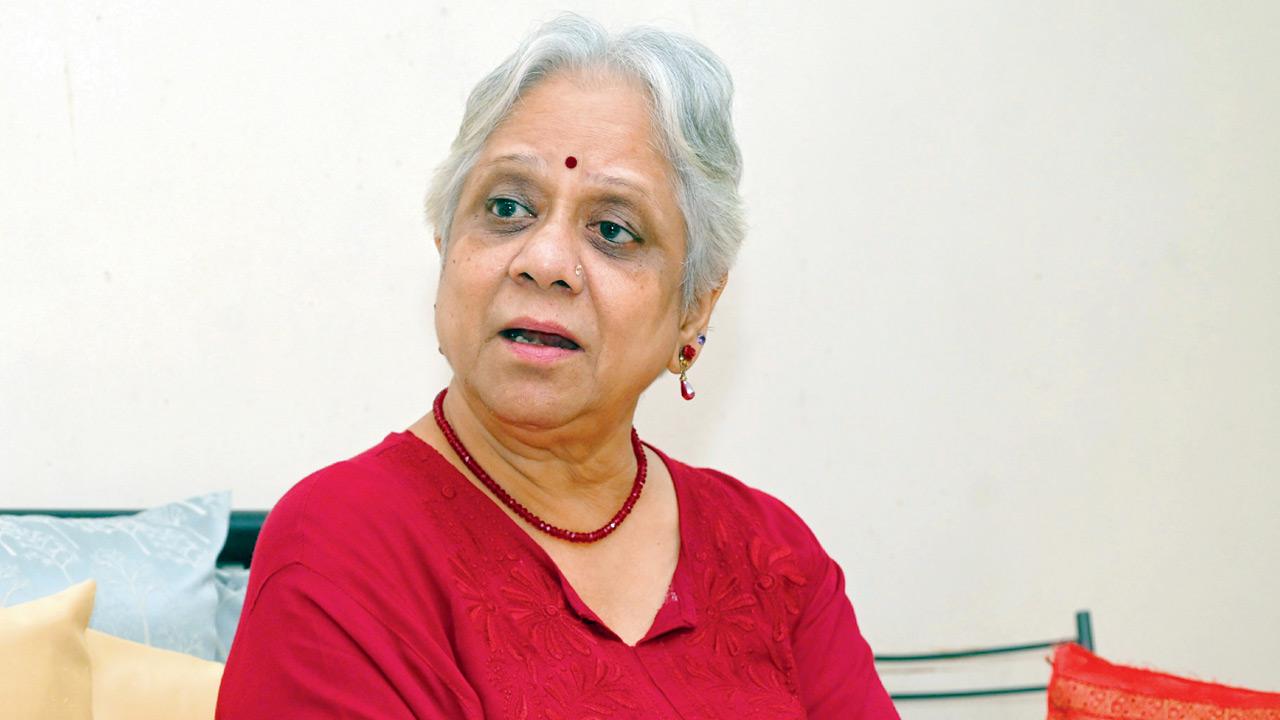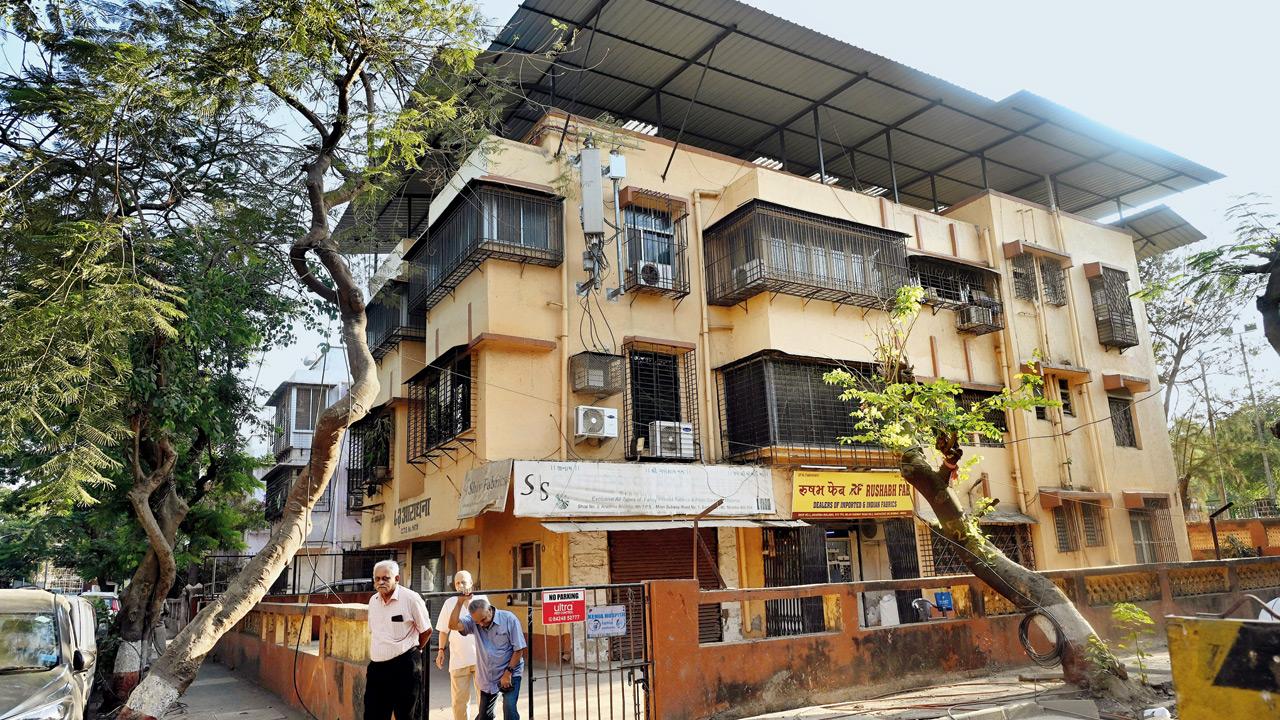Seniors in decaying homes relieved that redevelopment can finally happen, but technical issues could keep builders at bay; while many welcome the long-overdue funnel zone redevelopment policy, several loopholes—particularly around the Transfer of Development Rights (TDR)—and limited incentives have left them disillusioned

An airliner soars above the Town Planning Scheme 6 area of Santacruz West yesterday. Pics/Satej Shinde
The recently introduced funnel zone redevelopment policy has sparked mixed feelings among residents of crumbling buildings that fall under Mumbai airport’s funnel zone—the airspace around runways where the height of structures is restricted. Many such residents, especially senior citizens, are confined to their homes, unable to even step out for essentials.
ADVERTISEMENT
However, despite their desire for safer living conditions, they are unwilling to leave the only community they have ever known. While many welcome the long-overdue funnel zone redevelopment policy, several loopholes—particularly around the Transfer of Development Rights (TDR)—and limited incentives have left them disillusioned.
Locals’ woes
“I have been a resident of this society for the past 30 years. The building is over 65 years old. We have been facing many difficulties for several years. Most of these households have senior members. Since we lack a lift, going down to buy groceries has become quite difficult. Many of us are confined to our homes and are dependent on neighbours or their help to buy essentials. Also, we face heavy leakage problems during the monsoon season,” said Sharada Limaye, 75, a retired school principal residing in Om Mahant Society, Vile Parle.

Sharada Limaye, resident of Om Mahant Society at Navpada, Vile Parle East
The residents also have to deal with flooding during the monsoon. “Our buildings were constructed several years ago. Back then, the level of roads was quite low. Today, after massive road construction and concreting, the surface of the road has risen, leading to waterlogging every monsoon. At least once a year, water enters houses on the ground floor,” said Limaye.
The sound of aeroplanes frequently taking off and landing has also led to severe hearing loss for these residents. “The government has capped the noise levels at 65 dB for political meets and programmes that happen at Shivaji Park. However, the noise levels reach as high as 120 dB when each aircraft flies by. If you stand with a noise measuring app opened on your phone and check what the range is, it is never below 100 dB,” said Madhukar Yashwant Apte, 85, residing in New Pooja Co-Operative Housing Society, Vile Parle, When residents from Town Planning Scheme 6 in Santacruz approached private developers, they were faced with disappointment.

Residents of Town Planning Scheme 6 in Santacruz, who approached private developers a decade ago. Pic/Satej Shinde
“When we approached a developer some eight to 10 years ago, the offer they made was 30-35 per cent more space than the existing carpet area, a R5000 per sq ft corpus fund and rent amounting to Rs 125 to Rs 300 per sq ft. However, unfortunately, as self-redevelopment wasn’t a known term back then, the society members couldn’t come to an agreement. Today, after realising their problems are never-ending, society members are on the same page, but the developers have made unrealistic offers. Two months ago, we got a proposal where a developer offered 22-28 per cent extra space, a corpus fund of R500-700 per sq ft and rent of Rs 110-125 per sq ft. The developers’ mindsets have changed. They look at bigger profits today, making self-redevelopment non-viable,” explained Sanjay Patkar, 65, residing in Bhagyashree Society, Santacruz.
DGCA crackdown
While the government is lifting height restrictions, societies are facing notices from the Directorate General of Civil Aviation (DGCA) demanding the demolition of certain parts of buildings and the axing of trees. “I am supposed to attend a hearing on April 15 at the DGCA head office at Delhi. They have issued a notice to my building, stating that it’s creating hurdles and should be demolished from the top. The building is 55 years old. Was the DGCA sleeping all these years? We are retirees. We have to pay out of our pockets to attend these hearings,” said Shekhar Nair, 67, a resident of Neet-Geet Society, Santacruz.
Wadia Estate
During Partition, 30 colonies were established in Maharashtra for refugees who migrated from Pakistan. Wadia Estate colony in Bail Bazaar, Kurla West is one such colony. It comprises 19 buildings, each with a ground floor and two upper storeys. The surrounding area includes chawls and slums. There are also old encroachments in the open spaces within the colony.
Restrictions on the height of the buildings due to the colony’s proximity to the airport have discouraged developers from taking interest in redevelopment. “The buildings are more than 65 years old and have deteriorated significantly. Some have undergone minor repairs, but many are in a dangerous condition. There have been several instances of slab collapses. It is difficult for senior citizens and ailing residents to climb the two floors. During the monsoon, the terraces leak heavily,” said Mohan Ambekar, a resident of Wadia Estate, Kurla.
Locals’ demands
Residents are not interested in having huge towers. But they must compromise as the developers don’t show interest unless they can earn profits. Limaye said, “The problems of slum dwellers end when they are given homes for free. Some buildings here have been constructed even before the airport was established. And some were constructed simultaneously. Why did the government not think about the space required for the runway back then? We are just saying that give us TDR or help us reconstruct our buildings. Just because we do not live in slums or huts does not mean that we can afford to reconstruct our houses. The government should understand our problems and help us out. We are taxpayers. We understand the necessity of the airport. But we also have the right to peaceful life, which the government is bound to provide.”
Considering that they cannot leave the vicinity at their age, residents are unwilling to relocate to far-off places. “The government can take away our land. We only demand that we be relocated in the same area or 2 to 3 km away. Give us 40 per cent more space than our existing carpet area along with a market-rate corpus fund. At this age, no one wants a life where they are stuck in court cases,” said Ajit Ajgaonkar, 74, residing in Aaradhana Society, Santacruz.
Special concession scheme
Meanwhile, residents of Wadia Estate said that the government should not limit redevelopment incentive schemes only to areas strictly within the funnel zone but should also extend benefits to buildings and settlements in adjacent areas. This would help make redevelopment economically viable. “Buildings or settlements that face significant redevelopment hurdles due to height restrictions imposed by the airport funnel zone—where full utilisation of FSI [Floor Space Index] is not possible and additional FSI cannot be used—should be covered under a special concession scheme. This would ensure that redevelopment becomes viable and attractive to developers. There should be a special concession policy from the government specifically for refugee colonies. The scheme should be designed by considering dilapidated buildings, old encroachments on open lands, and height restrictions. Wadia Estate is one such settlement facing numerous issues like proximity to the airport, the Mithi River, encroachments, dilapidated buildings and a population comprising mostly economically weaker residents. Immediate redevelopment is the need of the hour,” Ambekar said.
Official Speak
“The revised funnel zone policy will pave the way for redevelopment of buildings in Ghatkopar, Santacruz, Vile Parle and Kurla, where projects were held up due to earlier restrictions. With this change, proposals that were on hold can now move forward, ensuring timely approvals and providing much-needed relief to residents living in structurally weak buildings. The need for quick action is well understood. Many buildings in these areas are in unsafe condition and require urgent redevelopment. Once the policy is in place, the focus must be on fast-tracking implementation. Residents have waited long enough, and their safety cannot be delayed due to procedural reasons. Wherever MHADA is the executing authority, rehabilitation of eligible residents will be carried out in line with the guidelines. We remain fully committed to protecting the interests of tenants and ensuring that they are accommodated appropriately as redevelopment moves ahead. The key issue is project viability in zones impacted by aviation height restrictions. However, as per DCPR 2034 clause 33(7), we are allowed to club schemes and use FSI across projects within a 10-kilometre range. This provision gives us the flexibility to make projects feasible. We will continue to use such policy tools to address challenges and proceed with redevelopment in a structured and lawful manner,” said Sanjeev Jaiswal, vice-president and CEO, MHADA.
Developers not motivated
Though developers are keen to take on more work, they aren’t willing to jump in yet as there are several hurdles, the viability of the project being the main one. “Areas in funnel zones are all prime locations. Any developer would be happy to take up the work. However, the government and DGCA aren’t on the same page. Moreover, redevelopment projects are not very viable. Additionally, TDR has been denied in these cases. There is no scope for a developer to earn profit and no developers are in a position that they can spend from their pockets considering rising construction costs,” said a spokesperson from NAREDCO.
What funnel zone residents want
>> Available land, official homes and encroachments that are protected under government resolutions should be properly accounted for.
>> Homes with a minimum carpet area of 500 sq ft should be provided to official homeowners
>> Encroached homes should receive homes/shops as per government schemes. The associated costs should be managed.
>> Any remaining FSI should be prioritised for TDR generation.
 Subscribe today by clicking the link and stay updated with the latest news!" Click here!
Subscribe today by clicking the link and stay updated with the latest news!" Click here!







